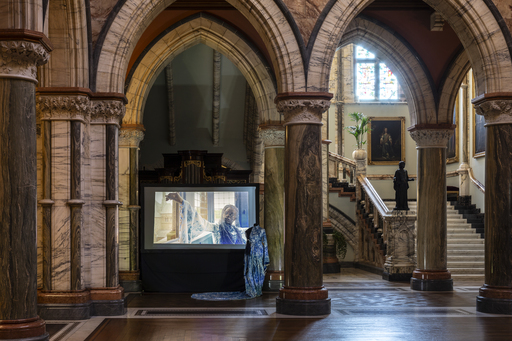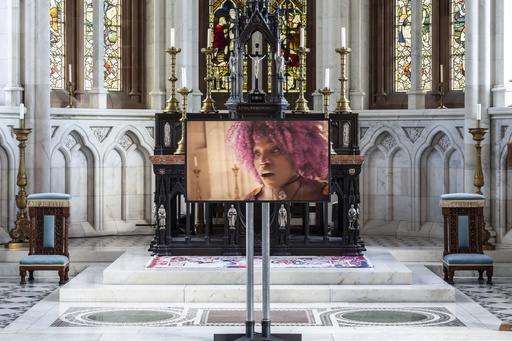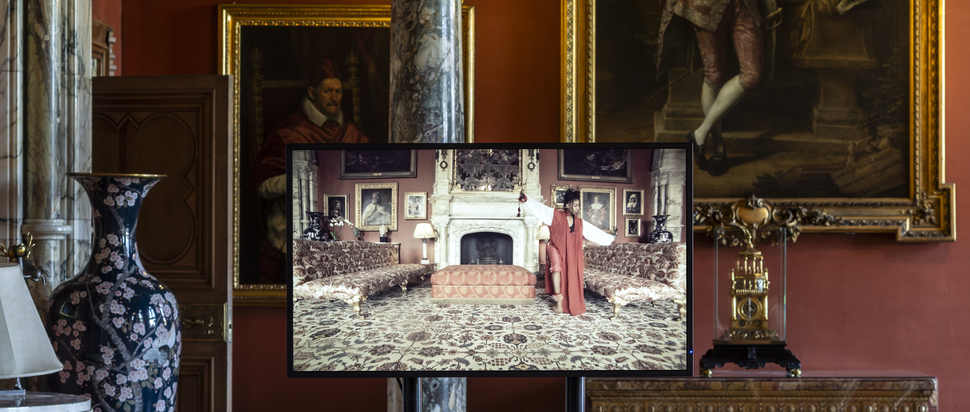Occult Visions: Sekai Machache at Mount Stuart
Sekai Machache’s immersive installation at Mount Stuart draws our attention to who was, and who is, absent in the archive – a reverent call to reinstate and to invoke those who have been silenced
Entering Mount Stuart on the Isle of Bute for the first time is a deeply ecstatic experience: its decadence and extravagance needs to be seen to be believed. This autumn, Sekai Machache occupies this cavernous house with her beguiling video installation Svikiro. Svikiro is a Shona word that refers to one who mediates between the spiritual and human world, who has the power to perform healing rituals (often through creative means such as dance and music) and to receive visions from the ancestral realm.
Machache uses the house itself, as well as its grounds and the island’s beaches, to spectacular visual advantage. Going further than challenging and contesting the problematic histories of the house and its origins, the artist draws on the spiritual, mythological and astrological details that are so embedded in the architecture and interior of the house. Every aspect of the film; the cinematographic attention to detail, the soundtrack, the intricately painted and embellished costumes, echoes the hyper-ornate nature of Mount Stuart itself.
Machache describes herself as "somebody who looks a lot at symbolism, especially occult and esoteric symbolism", which the house has in abundance, thanks to the Third Marquess of Bute’s penchant for the religious and the spiritual. "It's so embedded with that to a point where I was like, right, what is going on here?", she says. "What was the inspiration? How did it get to be like this? In the tours and the research that we did at the house, I learned a lot about the Third Marquess of Bute and all of his interests. He was interested in what can only be described as everything – and so the house has everything."
The house lies at the centre of 600 acres of grounds, densely packed with flora from all over the world. Its effervescent forest glades become the setting for one of several stunning performances titled Mutambi, choreographed and performed by Mele Broomes. One of the Marquess’s predecessors, the 3rd Earl of Bute, was fascinated by botany, even helping to fund the creation of Kew Gardens in London. During the development process, the artist was able to access Mount Stuart’s botanical drawings collection, which caught her attention: "it became a conversation around colonialism and botany, all these seeds coming from all around the world, creating these very densely packed grounds." An often neglected aspect of colonialism was the categorisation of plants and animals based on European ‘scientific’ theory. Indigenous knowledge was used by the imperialists to their own advantage: they claimed this knowledge as their own, using 'science' as a way of justifying the extraction of natural resources and the removal of indigenous people from their land.

The Banyan Tree, featuring Sekai Machache. Credit: Keith Hunter.
Seeds take on a particularly symbolic role in Svikiro – primarily in a beautifully intimate performance with friend and artist Alberta Whittle in one of the house’s bedrooms, titled Present Existence. The idea for the performance had been playing on Machache’s mind for several years, following a dream in which the words the sisterhood of the sacred leaves became ingrained in her mind: "I thought it was sort of like a kernel of information, a seed to be sown for something in the future. I was always like, when is this going to come up?"
Serendipitously, during a trip to Brazil, she met the Sisterhood of the Good Death, a collective of descendants of enslaved Afro-Brazilian women who practice Candomblé, a creolised religion which is grounded in Yoruba belief systems. Further seeds were sown for the artist during this trip to Brazil: "I was learning a lot about Afro-Brazilian experiences and through that learning about Afro-Colombian experiences. One of the features of the Afro-Colombian experience of the middle passage is that people would sew seeds and pieces of gold into their children's or loved one’s hair, with this idea that once they get to the other side, they would be able to sow these seeds and grow their own food. Or if they were planning an escape, they might braid seeds or rice into their hair. Then, when they made their escape, they would be able to actually start their own little plot from just the seeds that were stored in their own head. I thought that was, as an actual practice, such an incredibly subtle and beautiful form of resistance."
In another scene, Eyve Madyise performs a captivating call and response song, performed and co-written with Trisha Goddard. As she sings, we see the artist, adorned in an azure-painted dress (created for her 2021 work The Divine Sky) glide up the staircase, inviting us to join her in exploring the other facets of her film througout the grandiose house. It is this close attention to detail that keeps the viewer enthralled, so that the 45 minute runtime seems to elapse in mere moments. The constellation of recorded performances by Broomes, Whittle, Madyise and Goddard spread throughout the house are a welcome sight for those who are eager to see more of the numerous elements that have forged this film work, including bespoke costumes, jewellery and props from the performances. In the family bedroom, there is a copy of In the Wake: On Blackness & Being by Christina Sharpe. This book, along with Saidiya Hartman’s Lose Your Mother and Dionne Brand’s The Blue Clerk have been particularly influential on the artist’s thinking during the conceptualisation of Svikiro.
Sharpe’s concept of ‘wake work’ – ways of both resisting and creating against anti-Black violence, containment and incarceration – has been influential on Machache's working process. The poetic monologue – with its themes of bondage, severing and longing – feels particularly indebted to Sharpe, as does the brooding, almost-oceanic gestural performance also performed by Alberta Whittle. "[Sharpe’s book] is very, very densely packed with a lot of traumatic content. So I felt like in order to be able to engage with it, I needed to look at it more in a bird's eye view than at the very minutia of what she's saying – and what I felt was just the concept of ‘wake work’ itself and this idea of us existing as African diasporic people perpetually in the wake, perpetually trapped inside the hold. This concept of non-linear cyclical time that is expressed and experienced through our lived experiences, but also the epigenetic memory, the visualisation, and the imaginary."

Svikiro Tripano, featuring Eyve Madyise. Credit: Keith Hunter.
The soundtrack that attends to the film is formed of delicate, silky harp and mbira flourishes, gentle and tinkling like a mountain stream – but, at times, it becomes oceanic, vast, epic (particularly when it accompanies the gestural performance performed by Whittle). The approach to filmmaking is just as expansive – it feels fluid and embodied, partially a result of a decision to collaborate with a team of three videographers who hadn’t previously worked together. Machache emphasises that the work was very much a collaborative effort: "I want to really signpost that I did not do all of that work myself. There were 15 people on my team, all of them incredible. We've got a space in the exhibition that we've curated with behind-the-scenes film and pieces that represent everyone's work in some capacity. So I want to make sure that all of the team's work is really, really considered because it's my work and it's my conceptualisation, but I could not have done it without everyone that was involved."
Excitingly, during the making of Svikiro, it was announced that Machache had been one of five artists selected to represent Zimbabwe at the 2024 Venice Biennale. The selection was a very emotional moment for the artist: "It was all very quick and just surreal actually… I was supposed to be on a Zoom call to sit in the meeting when they made the announcement, and I somehow wasn't able to be in the meeting, and I'm so glad I wasn't, because the moment that I found out I just burst into tears. I think when you're recognised at home as a diasporic person, nevermind just for being an artist… It's huge. I
"'ve been making work that has engaged with so many different ideas from different cultures, but in the last few years I've really engaged further and deeper into Shona spiritual concepts and practices. Although I'm not in Zimbabwe, not spending my day-to-day there, I'm thinking about my past and my ancestral knowledge that lives inside my body and in my DNA: I'm engaging with it in a way that maybe I wouldn't be able to if I was actually living there. So I'm quite honoured to have been invited to make work to elucidate some of that for myself and for other people."
Sekai Machache, Svikiro, Mount Stuart, until 29 Oct, for more detailed opening times visit https://www.mountstuart.com/visiting
